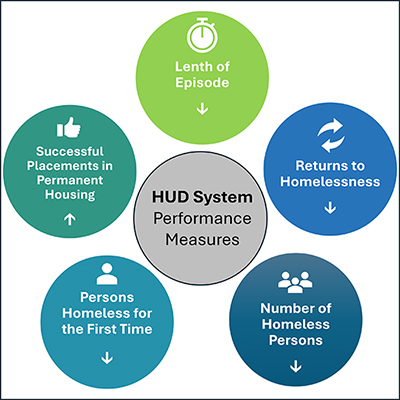Homeless System Performance Measures

The System Performance Measures (SPM, developed by the U.S. Department of Housing and Urban Development (HUD), reveal the performance of a community’s homelessness services system as a whole. Instead of focusing solely on individual projects, the SPM allows communities to assess their overall impact, successes, and challenges. This enables communities to design and implement data-driven and outcome-driven homeless response systems. The SPM are used by Utah and its Local Homeless Councils (LHCs) to understand annual and long-term trends, revealing the impact of strategies and approaches defined in their plans to address homelessness. The graphic highlights the HUD SPM measures that are particularly relevant for evaluating homeless services in Utah.
Unlike previous versions of the Annual Data Report on Homelessness, the SPM data presented in this dashboard is provided for the calendar year rather than the federal fiscal year. This change was made to make the data more relevant and timely to Utah and the work of its LHCs. As a result, this data cannot be combined or directly compared to data for federal fiscal years published in previous reports.
It is also important to note that the SPM are calculated exclusively from the Utah Homeless Management Information System (UHMIS). UHMIS is the most comprehensive and accurate data source on homeless services in the state. Containing data from the vast majority of homeless service providers in the state, UHMIS provides a unique understanding of who experiences homelessness in Utah and the availability and outcomes of homeless services over extended periods of time. Despite these strengths, not all Utahns experiencing homelessness or homeless services provided in Utah are included in the SPM, as some providers are prohibited from entering or choose not to enter data into UHMIS. Examples include domestic violence service providers and some faith-based providers. People experiencing unsheltered homelessness can also be underrepresented in UHMIS data due to the limits of formal outreach teams.
Combining SPM data with complementary data from the PIT and HIC creates a clearer, more complete understanding of homelessness and the impact of the response system in Utah.